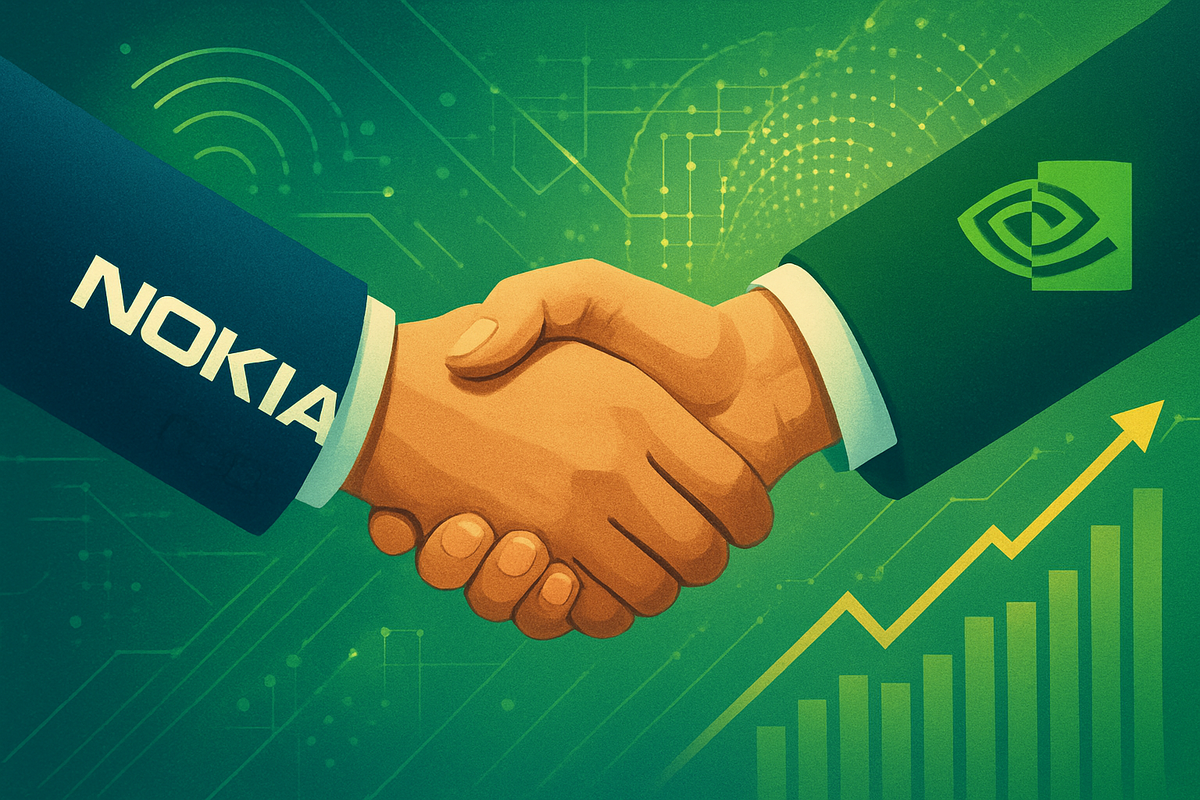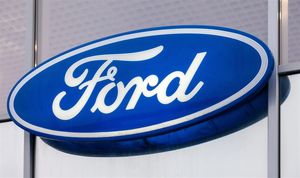
Helsinki, Finland – October 28, 2025 – Nokia (HEL: NOKIA) stock surged dramatically today following the announcement of a monumental $1 billion equity investment from Nvidia (NASDAQ: NVDA). The strategic alliance, which grants Nvidia a 2.9% stake in the Finnish telecommunications giant, is poised to accelerate innovation in AI-RAN (Radio Access Network) and pave the way for the transition from 5G to 6G, sending a clear signal to the market about the future of intelligent network infrastructure.
The news, breaking on Tuesday, October 28, 2025, immediately electrified investors, propelling Nokia's shares upward by an estimated 15% to 25% in both Helsinki and U.S. trading. This marks Nokia's most significant intraday gain in over a decade, reflecting profound investor confidence in the partnership's potential to position Nokia at the forefront of the burgeoning "AI supercycle" by delivering critical connectivity solutions for an increasingly AI-driven and cloud-centric world.
A Strategic Power Play: Unpacking the Nvidia-Nokia Alliance
The core of this transformative event is Nvidia's commitment to subscribe for approximately 166.4 million new Nokia shares at a price of $6.01 per share, totaling a staggering $1 billion investment. This move is not merely a financial transaction but a deep strategic partnership aimed at revolutionizing the telecommunications landscape. Nokia intends to leverage these proceeds to significantly bolster its strategic initiatives, particularly in accelerating the development of its advanced 5G and future 6G RAN software. Crucially, this software will be optimized to run on Nvidia's cutting-edge architecture, creating a powerful synergy between hardware and software.
The collaboration extends beyond RAN, with both companies exploring the integration of Nokia's robust data center switching and optical technologies into Nvidia's future AI infrastructure. This holistic approach signals a joint effort to build a comprehensive, AI-native network ecosystem, from the edge to the core. The timeline for this event is immediate; the announcement and subsequent market reaction occurred entirely on October 28, 2025, making it a pivotal moment in current financial news. Key players are undoubtedly Nokia (HEL: NOKIA), a long-standing leader in telecom equipment, and Nvidia (NASDAQ: NVDA), the dominant force in AI computing and graphics processing. Initial market reactions have been overwhelmingly positive, with analysts highlighting the strategic fit and the potential for Nokia to capture significant market share in the rapidly evolving AI and cloud infrastructure domains.
Market Winners and Losers: The Ripple Effect
This strategic investment by Nvidia (NASDAQ: NVDA) into Nokia (HEL: NOKIA) is set to create distinct winners and losers across the telecommunications and technology sectors. Clearly, Nokia emerges as an immediate victor. The $1 billion cash infusion provides significant capital for R&D, allowing it to accelerate its AI-RAN and 6G development roadmaps. More importantly, the partnership with Nvidia, a company synonymous with AI innovation, lends immense credibility and technological prowess to Nokia's network solutions. This could significantly strengthen Nokia's competitive position against rivals like Ericsson (STO: ERIC-B) and Huawei, particularly in the advanced 5G and nascent 6G markets where AI integration will be paramount. Investors in Nokia stand to gain from the enhanced market valuation and future growth prospects.
Nvidia also stands to gain substantially. By investing directly in Nokia, Nvidia deepens its footprint in the critical telecommunications infrastructure sector. As AI applications become more pervasive, the demand for high-performance, AI-optimized networks will skyrocket. Nvidia's strategic stake ensures its hardware and software platforms are deeply embedded in the foundational layers of future networks, creating new revenue streams and expanding its ecosystem influence beyond traditional data centers. This move could also put pressure on other semiconductor companies vying for a share in the telecom infrastructure market, potentially challenging the status quo.
Conversely, competitors of Nokia, such as Ericsson (STO: ERIC-B) and Samsung (KRX: 005930), might face increased competitive pressure. While these companies are also investing in AI and 5G/6G, the Nvidia-Nokia alliance creates a formidable, integrated offering that could be difficult to match. Companies that rely on traditional RAN architectures without robust AI integration may find themselves at a disadvantage. Furthermore, other chipmakers that supply components for RAN infrastructure might see their market share eroded if the Nokia-Nvidia partnership leads to a more vertically integrated solution. The long-term implications for these companies will depend on their ability to innovate and form equally impactful strategic alliances.
Broader Implications: Reshaping the Telecom and AI Landscape
The Nvidia-Nokia partnership extends far beyond the immediate financial gains, signaling a profound shift in broader industry trends. This event firmly places AI-RAN at the forefront of telecommunications innovation, accelerating the convergence of AI, cloud computing, and network infrastructure. It underscores the industry's pivot towards open, software-defined networks that can leverage general-purpose computing platforms, a trend that Nvidia (NASDAQ: NVDA) has championed. This collaboration will likely serve as a blueprint for future alliances, pushing other telecom equipment providers and chipmakers to forge similar partnerships to remain competitive in the race towards 6G and ubiquitous AI.
The potential ripple effects on competitors and partners are significant. For partners within Nokia's existing ecosystem, this could mean new opportunities to integrate their solutions with Nvidia's powerful AI platforms, potentially creating a more robust and diverse offering. For competitors like Ericsson (STO: ERIC-B) and Huawei, the pressure to innovate and demonstrate their own AI capabilities within their RAN offerings will intensify. This could lead to a wave of increased R&D spending and strategic acquisitions across the sector. Regulatory bodies will also be closely watching, particularly regarding market concentration and interoperability standards, as the telecom infrastructure becomes increasingly complex and reliant on specialized AI hardware and software.
Historically, the telecommunications industry has seen similar transformative partnerships, such as the early collaborations that propelled 3G and 4G technologies. However, the scale and strategic depth of this Nvidia-Nokia investment, coupled with the rapid advancement of AI, suggest a potentially more disruptive and far-reaching impact. It draws parallels to the early days of cloud computing, where strategic alliances between hardware providers and software developers reshaped the enterprise IT landscape. This event positions the telecommunications sector at the cusp of its own "AI supercycle," where intelligent networks become the backbone of an AI-driven global economy.
The Road Ahead: Navigating a New Era of Connectivity
The immediate future for Nokia (HEL: NOKIA) will involve swift execution of its strategic plans, leveraging the fresh capital and Nvidia's (NASDAQ: NVDA) technological expertise to accelerate its AI-RAN and 6G development. Short-term possibilities include rapid prototyping and deployment of AI-enhanced network features, potentially leading to early market wins in specific segments. Long-term, this partnership could fundamentally redefine Nokia's market position, transforming it from a traditional telecom equipment vendor into a pivotal enabler of AI-driven digital infrastructure. This will likely necessitate strategic pivots, including a deeper integration of AI talent and methodologies across Nokia's R&D divisions and a focus on software-centric solutions.
Market opportunities will emerge in several key areas. The demand for high-performance, low-latency networks capable of supporting complex AI workloads, from autonomous vehicles to advanced industrial IoT, is growing exponentially. The Nokia-Nvidia alliance is uniquely positioned to capture these opportunities. Challenges will include fierce competition, the need for seamless integration of disparate technologies, and navigating evolving global regulatory landscapes. Potential scenarios range from Nokia establishing a dominant position in AI-RAN, setting new industry standards, to a more gradual integration process that still yields significant competitive advantages. The success hinges on the effective collaboration and innovation capacity of both companies.
For Nvidia, this investment marks a significant expansion of its influence into a critical infrastructure layer. It solidifies its position as a foundational technology provider for the AI era, demonstrating its commitment to not just powering AI in data centers but enabling it across the entire network fabric. This could lead to further investments in other sectors critical to the AI ecosystem, as Nvidia seeks to build a comprehensive, end-to-end AI infrastructure. The partnership sets a precedent for how technology giants will collaborate to build the next generation of digital infrastructure.
A New Dawn for Telecom: The AI Supercycle Accelerates
The $1 billion investment by Nvidia (NASDAQ: NVDA) in Nokia (HEL: NOKIA) represents more than just a financial transaction; it is a declaration of intent, signaling a new era for the telecommunications industry. The key takeaway is the acceleration of the AI-RAN paradigm, where artificial intelligence is not merely an add-on but an intrinsic part of network design and operation. This strategic alliance underscores the critical importance of intelligent, software-defined networks for the coming "AI supercycle," positioning Nokia to capitalize on the explosive growth of AI-driven applications and services.
Moving forward, the market will closely scrutinize the execution of this partnership. Investors should watch for concrete product roadmaps, early deployments of AI-RAN solutions, and any further strategic collaborations that might emerge from this foundational alliance. The success of this venture could serve as a bellwether for the entire telecom sector, influencing how other players adapt to the demands of an AI-first world. The lasting impact could be a complete reshaping of the competitive landscape, with a stronger emphasis on integrated hardware-software solutions and deep technological partnerships.
This event solidifies the notion that connectivity is no longer just about moving data, but about intelligently processing and managing it at every point in the network. The Nokia-Nvidia partnership is a bold step towards realizing this vision, promising a future where networks are as intelligent as the applications they support. The coming months will reveal the initial fruits of this collaboration, setting the stage for what promises to be a transformative period for global telecommunications.
This content is intended for informational purposes only and is not financial advice





